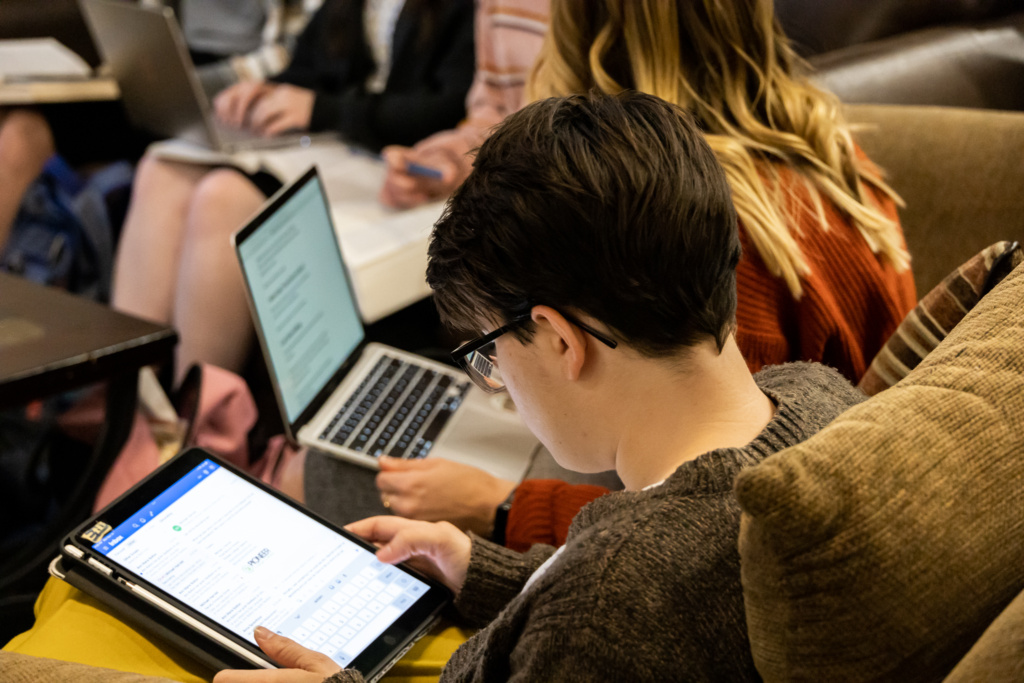5 Ways to Make the Most of Your Study Time
Have you ever settled in to do homework only to find yourself browsing through Instagram or Facebook ten minutes later? Or have you started writing a paper only to be interrupted by the ding of a text notification? Trust me, we’ve all been there. Sometimes it may seem like the world wants to stop you from getting your assignments done. Fear not! Here are five tips to make the most of your study time.
1. Choose an Appropriate Study Spot
Location is foundational in making the most of your study time. First, it’s important to consider how you study when you choose where to study. Some students thrive in social areas like coffee shops or dining areas. Instead of becoming distracted by the bustle around them, they transform it into white noise that helps narrow their concentration. In fact, YouTube even offers hour-long videos with audio from actual coffee shops to help these students study.
On the other hand, there are those students who appreciate quiet areas like the library, their dorm room, or a nice park. They may get easily distracted by loud sounds, or even by people passing by. For them, they work best when they’re able to concentrate without any disruptions.
Ultimately, most students fall into either of these categories, and it’s important to know which one you fit in. Location makes all the difference when you’re trying to study, and any other way to remain focused on homework rests in where you choose to work. If you’re drawn to social areas, try the Old Main Café on campus. Otherwise, if you prefer quiet locations, consider Cedarholm Library. Both have a variety of study spots to fit your needs.
2. Set Clear and Attainable Goals
Whether it’s in the form of a checklist, a mental stopping point, or a sequence of sticky notes hung above your laptop, precise goals are an essential component to maximize your study time and limit distractions. When you create specific goals for yourself, you’re more motivated to reach them. Goals give your brain an incentive to stay focused on important tasks because it anticipates the satisfaction of completing the task.
Goals should not stop there. Write out the goals you have for your classes as a whole, not just for each study session. Perhaps you want to complete a class with a certain grade or develop a particular skill. Clarifying that goal helps motivate you to attain it. Also, you should make your goals specific and attainable. Making your goals too broad leaves room for re-interpretation or the excuse to do less than you’re capable of. At the same time, you should make them attainable. Don’t set the bar too high, or you’ll fall short every time. You should be able to reach your goal by doing your best work.
3. Download a Focus App
We live in an age of technology, and our smartphones have apps for almost everything. Focus apps have been especially popular with college students. These types of applications help students stay off their phones for long periods of time. Though they all differ in their content, the overall purpose of focus apps is to keep students from the temptation of distraction.
Essentially, the student sets a timer on their focus app, and if they close the app for any reason during this time period, some form of consequence occurs within the app. For instance, some apps feature virtual forests that users can cultivate by setting timers. The longer the timer, the more plants that grow. If the user completes the timer without closing the app, he or she will be rewarded with a new addition to their forest. Though, if the user closes the app, the plant will either stop growing or wither. Apps like these are great motivators for those who tend to pick up their phones during study time, and they offer satisfying rewards for completing the study timer. If you don’t know where to start, try Forest, an app that allows you to plant a virtual forest as you stay focused on your work.
4. Create a Playlist
Playlists serve as a happy medium for those who get distracted by complete silence but still cannot work in an overly stimulating environment. From classical music to movie soundtracks to rainforest sounds, students can choose the background sounds that best fit their study habits. Apps like Spotify, Amazon Music, and Pandora provide useful tools for making these kinds of playlists, so you won’t have to keep manually restarting the track. And if you don’t know where to start, YouTube offers a wide range of background sounds to discover.
5. Take Breaks When Needed
This may seem counterproductive to your overall productivity, but taking appropriate breaks has actually been shown to increase concentration. Even for those with long attention spans, breaks are essential to give the mind a chance to rest. Often students will find that they are able to concentrate better when they pause their work, take a walk or complete another activity, and then resume after a mental rest.
One increasingly popular technique is the Pomodoro Technique. This method permits a five-minute break for every twenty-five minutes of studying. These short, frequent breaks allow the brain to reset in preparation for the next block of study time and may even increase the level of productivity during those sessions.
Above all, don’t be too hard on yourself! Everyone gets distracted at one time or another. Just make sure to get back on track and keep working toward your goal. At the same time, allow yourself time to enjoy the activities you love. Work and fun should be a balance, and leaning one way or the other can result in either burnout or procrastination. Remember, good study habits begin with a healthy lifestyle. Now go tackle those assignments!


